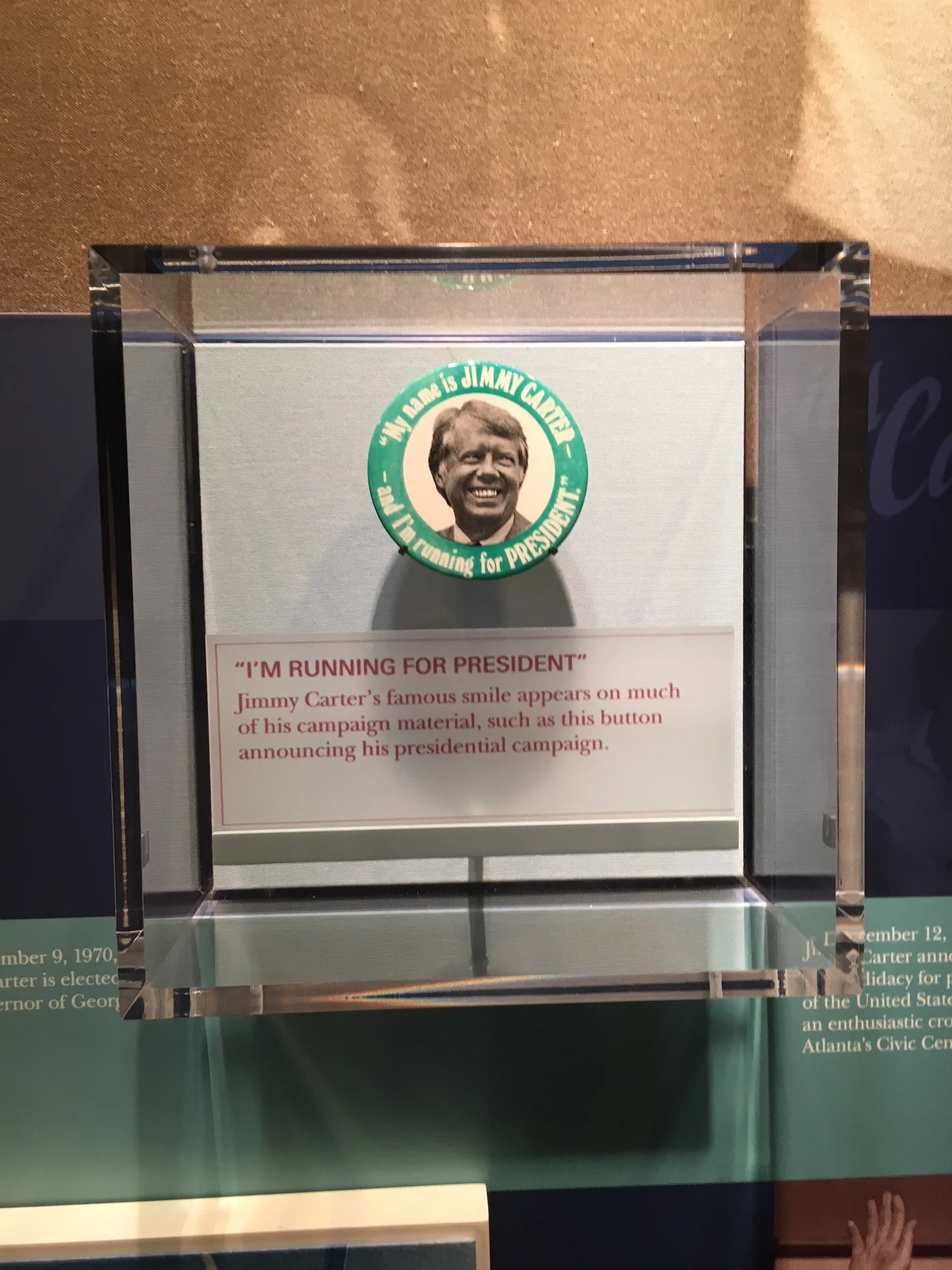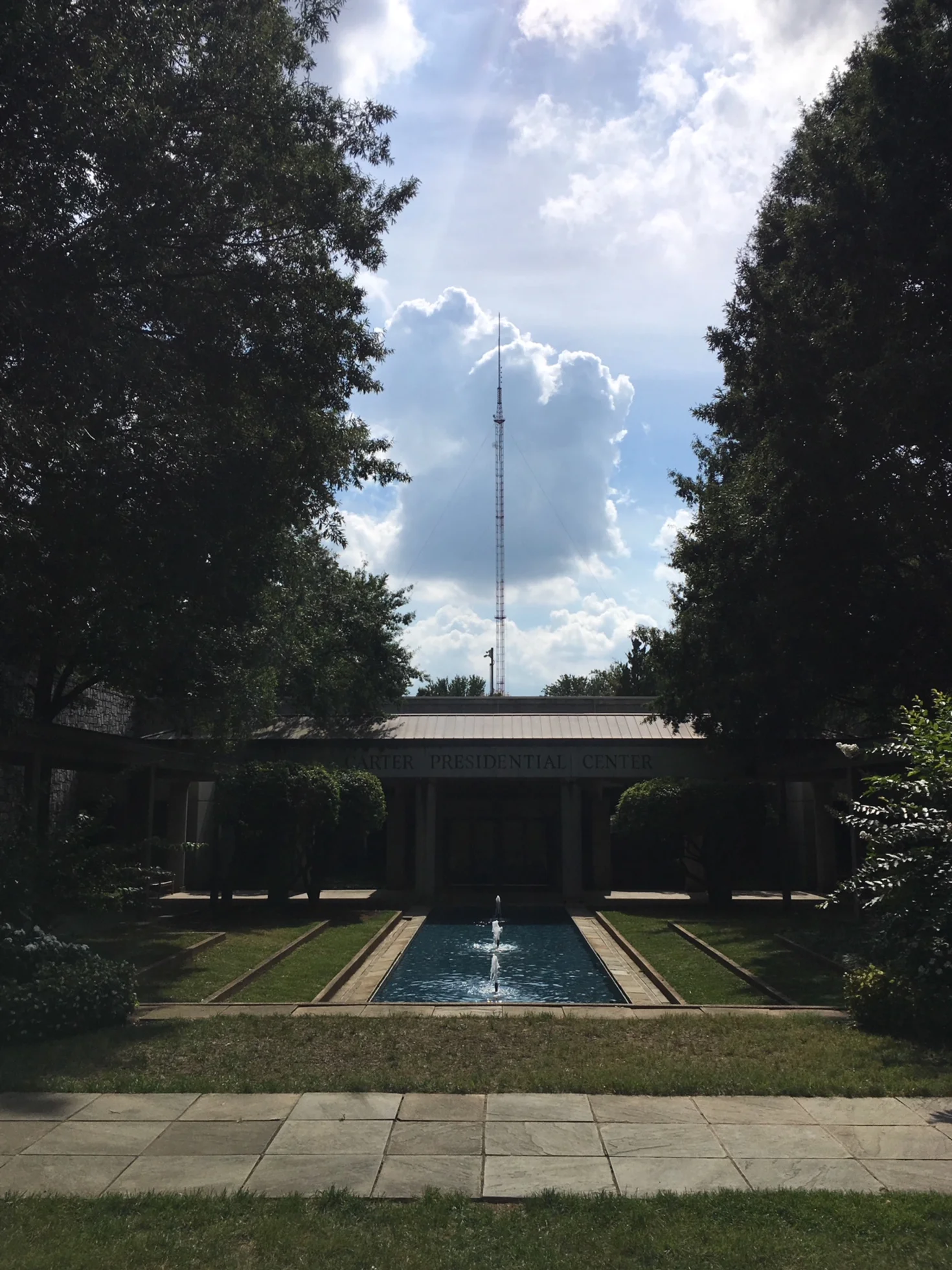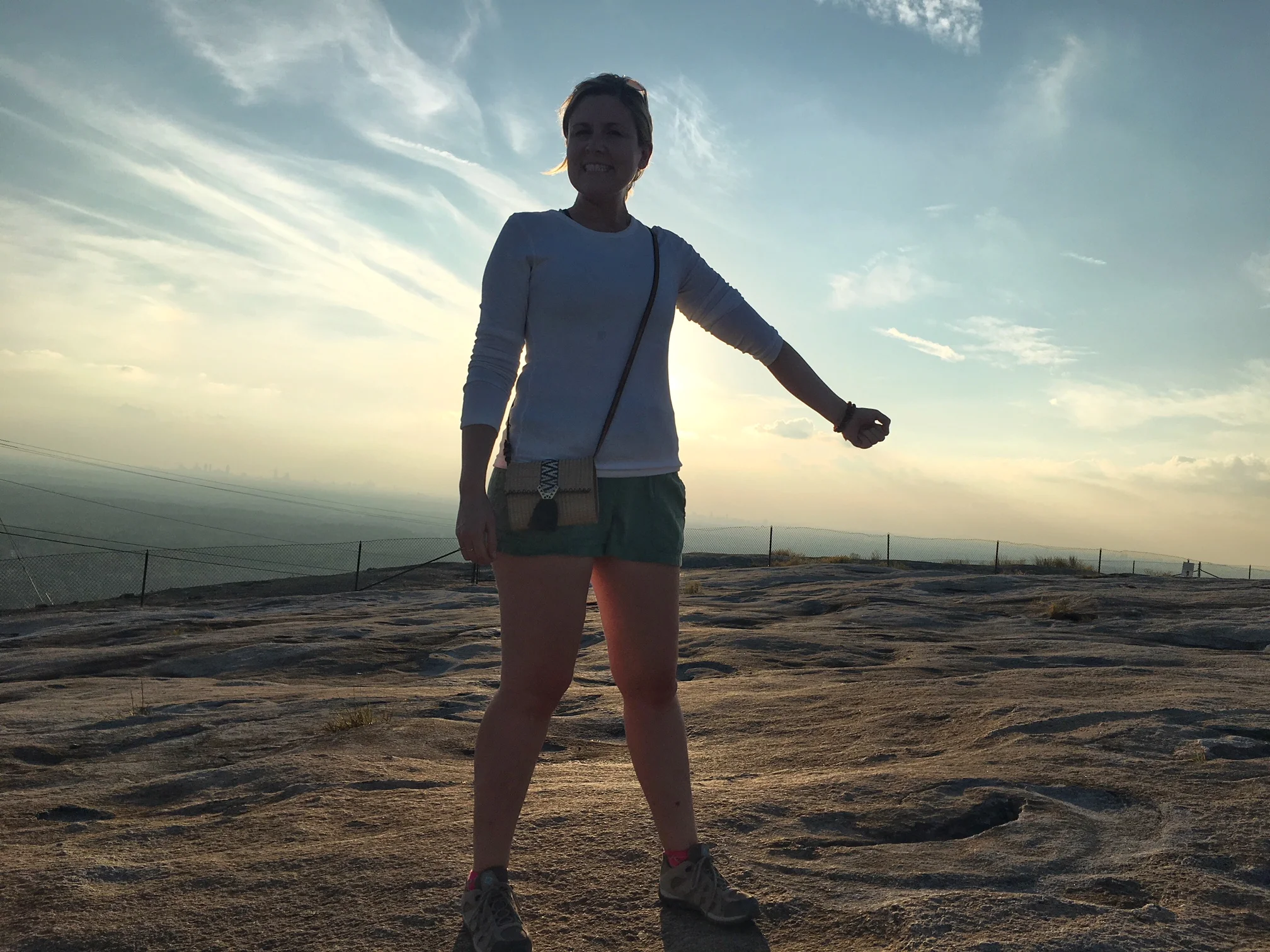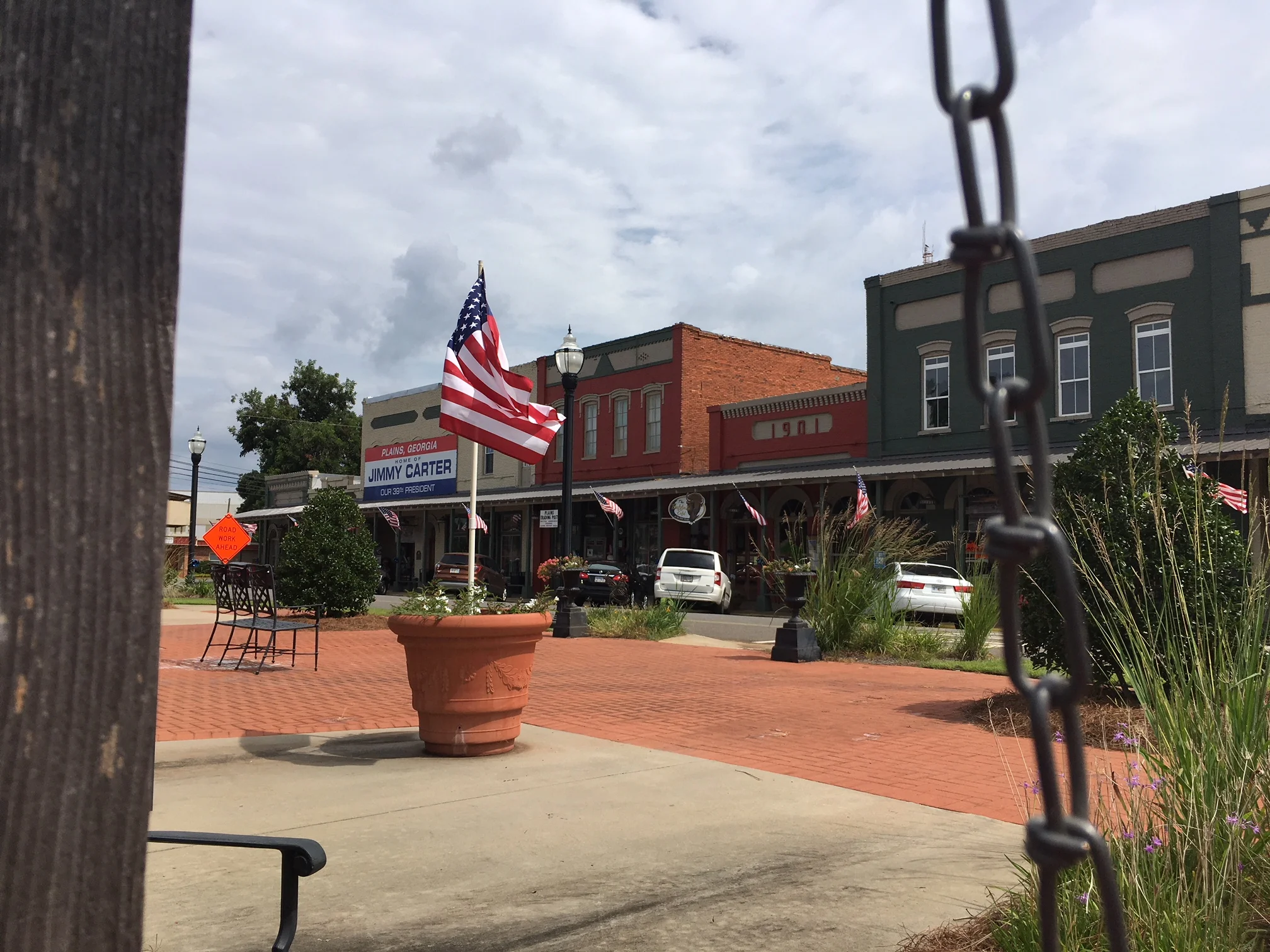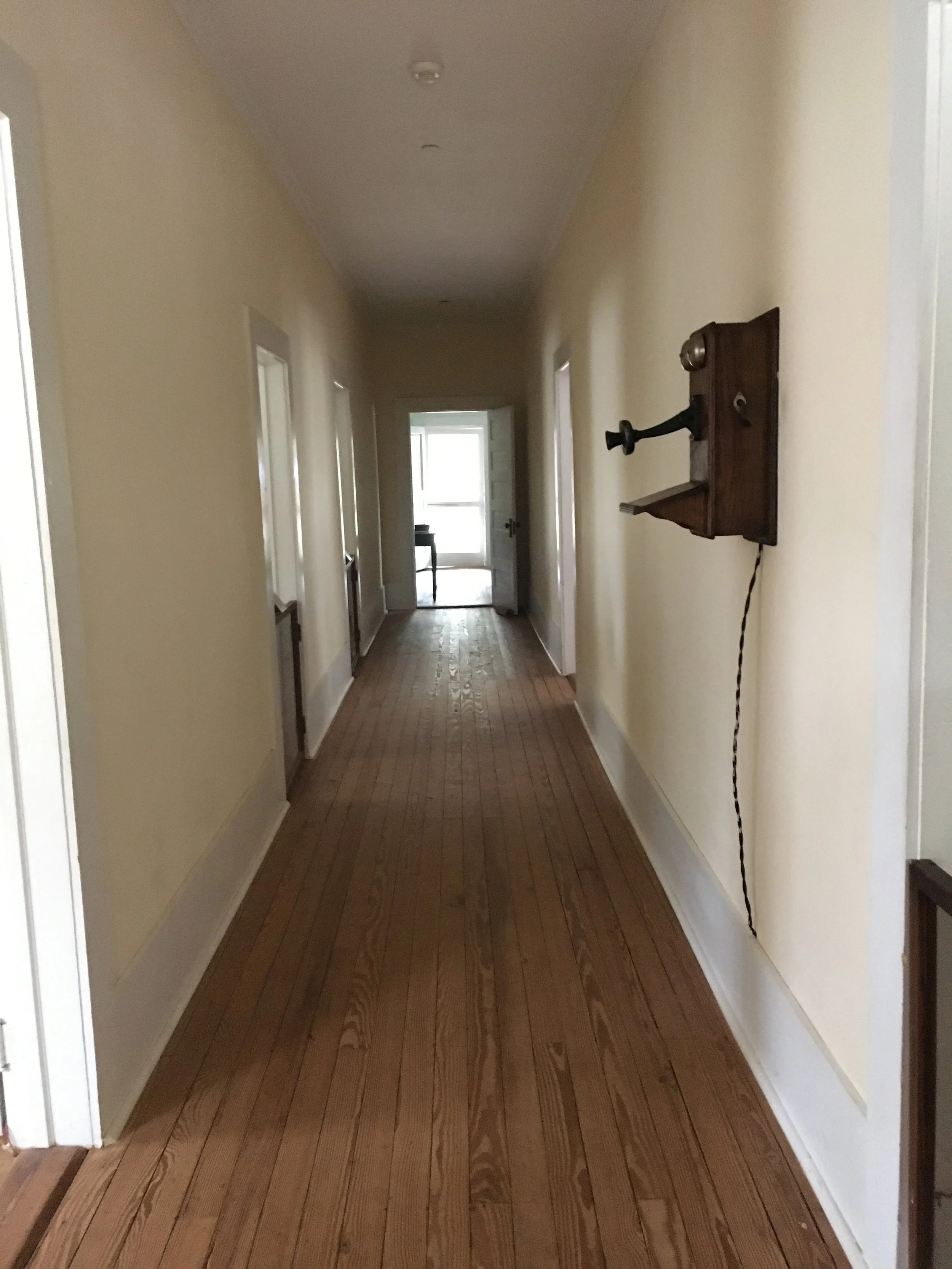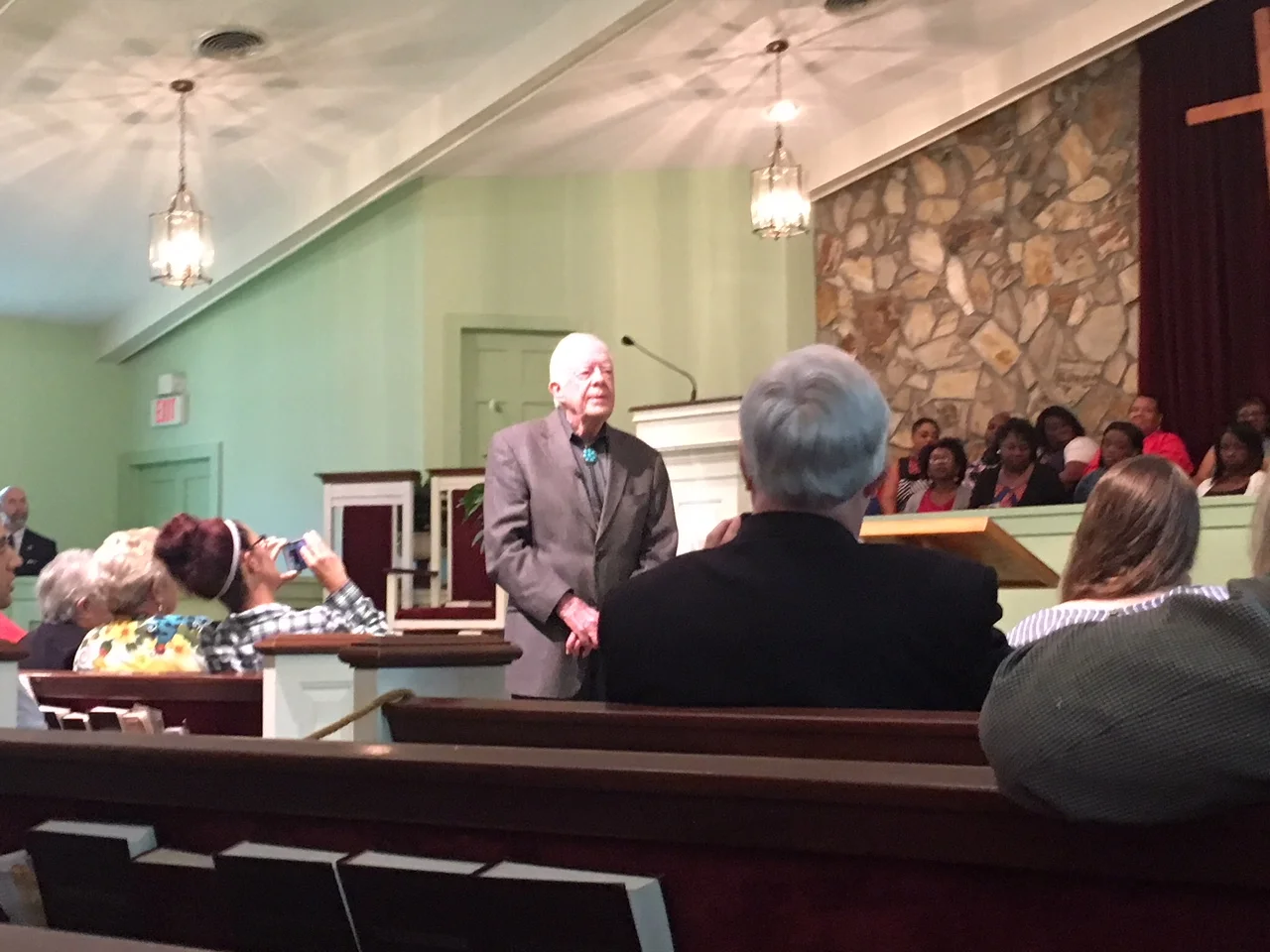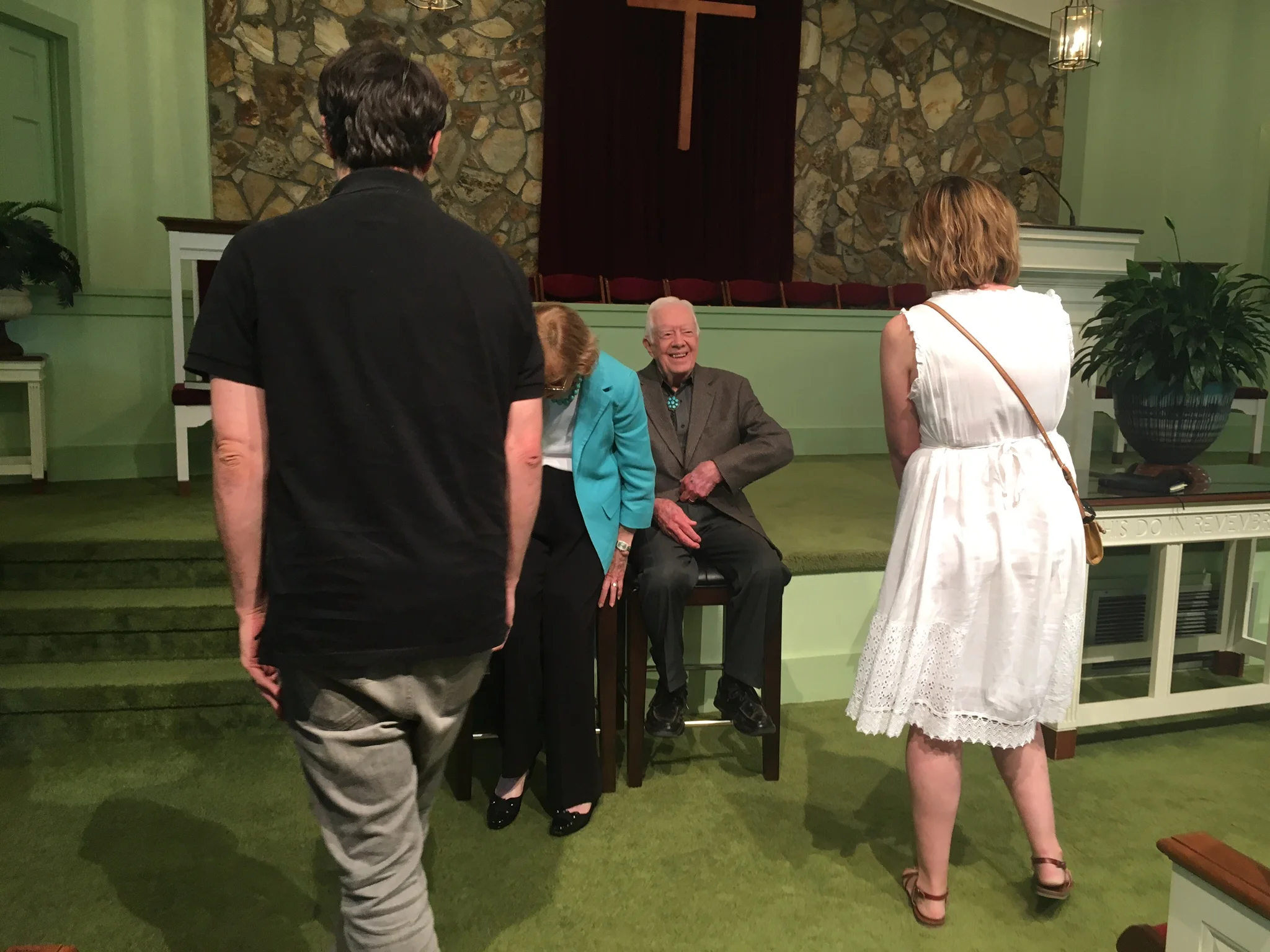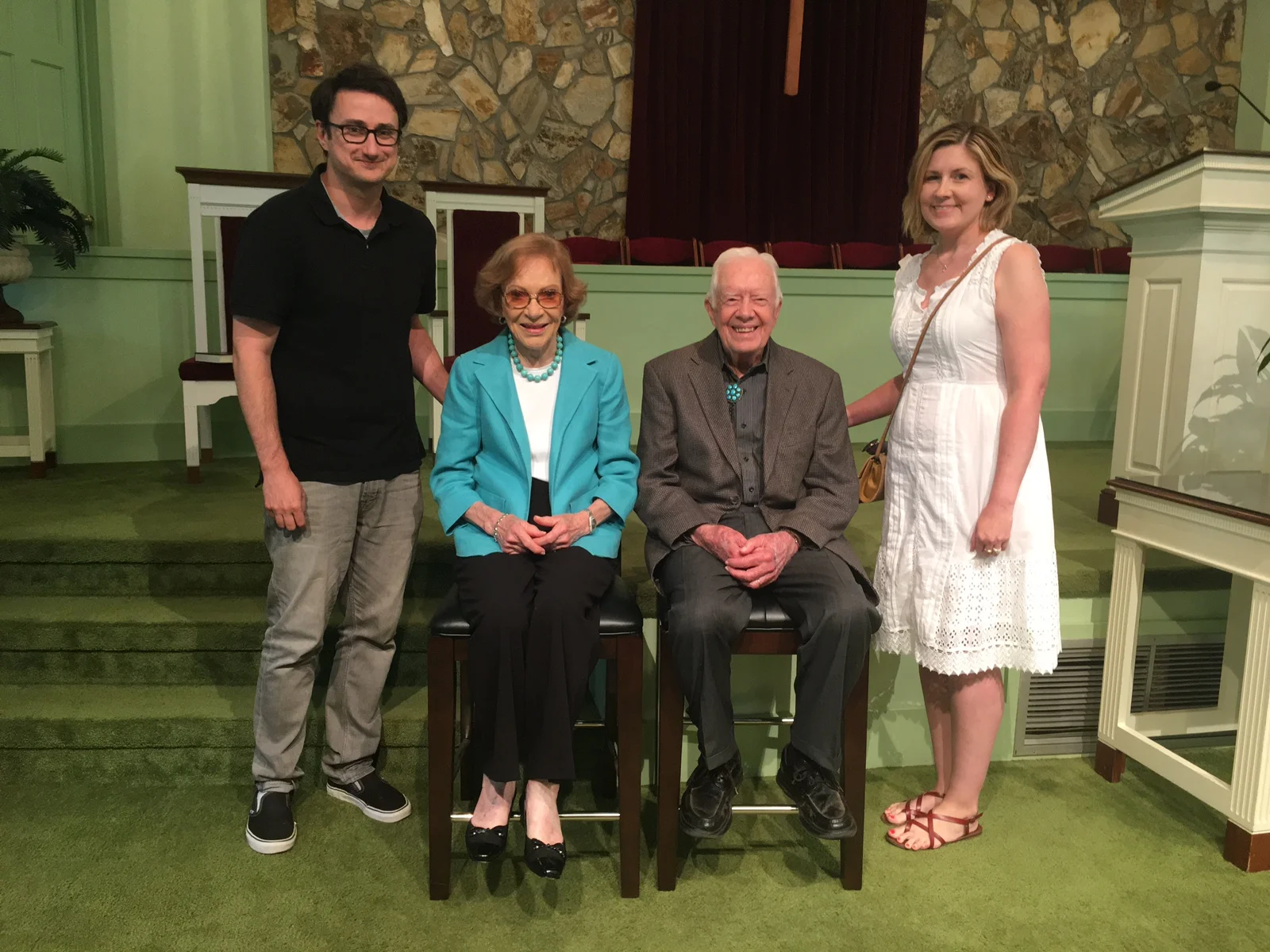The Capacity for Choice
“The bond of our common humanity is stronger than the divisiveness of our fears and prejudices,” Jimmy Carter said. “God gives us the capacity for choice.”
In the Oval Office (circa 1978) (photo by Steven Seighman)
After we finished our dinner at Pittypat's Porch, a 50-year-old Gone With the Wind-themed restaurant on Andrew Young Boulevard, named after the esteemed civil rights activist (Georgia is a study in contradictions), I tried to convince my husband, Steven, once again to go climb Stone Mountain.
Some time after 1974, when my parents met, they also ate at Pittypat's Porch (a brand-new restaurant then) and took photos at the top of Stone Mountain. My mom had traveled with my dad to Georgia to show him her grad school. She still can't believe her time at University of Georgia lasted just a little over a year and often talks about it like it was the most liberated experience of her life. I wonder sometimes how her life might have gone differently had she stayed. But in that scenario, I'm never born, so I can't exactly favor it.
My beautiful mom in her UGA Bulldog days (she built that shelf to the left herself) (photo courtesy Joan Wilson)
The potential for seeing her old stomping grounds was almost enough to convince her to take this trip with me. But at the last minute, she gave me an envelope of old photos and told me to go with my husband instead. So I knew I had to recreate those shots. This was my first time checking off an item on my dad's list in a place he'd actually gone to.
I was in Georgia to check off Item 6, "Talk with the President."
The seed for the trip was planted back in April, after my Good Housekeeping article about the List came out. The PR person at work kept saying other press would follow, but nobody bit. Then, on my dad's birthday, Inside Edition called. While being interviewed, I joked about what many have called the most difficult list item.
I knew too well how impossible it sounded. Though I hadn't known about my dad's bucket list, which he wrote the year I was born, I'd heard throughout my childhood about his grandiose ideas—like thinking he might meet the president. And he'd written this just after the most secretive presidency in our history. There was a time, of course, when civilians could simply walk into the White House—a tradition started by my dad's favorite president, Thomas Jefferson. But after too many assassination attempts—some successful—that time had come and gone.
A week after my interview I received an email from an Alabama man named Mike Hicks: “I saw a video of you discussing your father's ‘bucket list.’ One of the items was talking with the President. While it may be difficult to speak with a sitting president, President Carter still teaches Sunday school in Plains, Georgia, several times each year. There is a calendar of his classes at mbcplains.org if you decide that would satisfy the list. Good luck with everything.”
My dad wrote the list when Carter was in office, so Jimmy Carter would have fit the description. Could talking with him satisfy this item? I started researching his handling of vehicle safety, what I'd decided to "talk with the President" about, just in case.
How people felt about seat belts in the 1950s
By the early 1970s, the number of needless deaths from car wrecks numbered over 54,000 a year (the current deaths per year are about 41,000—the climb the past two years alone was the highest percentage year-over-year increase since the 1960s, and many experts attribute it to distracted driving). In 1967, the National Highway Traffic Safety Administration with the help of Ralph Nader convinced Congress that automakers needed safety standards, and seat belt installation in cars became mandatory (though laws about wearing them varied by state, much like distracted driving laws do today). By 1972, studies showed that only 10 percent of drivers were actually wearing the mandatory belts.
In 1978, Carter wrote a letter to Congress, and his administration later demanded a standard for automatic seat belts. He did this much to the dismay of lobbyists, which was pretty much how he did everything. Automatic seat belts didn't become mandatory until well into the 1980s. They ended up cutting traffic deaths considerably. Though Carter had been adamant about traffic safety, it was still another decade before we started seeing a real difference. But at least he tried. He didn't let big business push him around.
I decided this was a good enough reason to meet him.
While anyone can do it, attending Jimmy Carter's Sunday school is a highly regimented affair and provides no guarantees of actually talking with him. As I learned more about it, I found myself in disbelief that this man makes himself so readily available to the general public.
And then I saw the footage of him shaking hands with everyone on a plane. The video went viral on social media, where people seemed nostalgic for Carter's kindness and lack of mean tweets.
So I drafted a well-thought-out email to Carter's press secretary. Then in July, Carter passed out from dehydration at a Habitat for Humanity site in Canada. He was there to build 150 homes in celebration of Canada's 150 years of confederacy. At 93 and 90 respectively, Jimmy and his wife, Rosalynn, still volunteer to help build homes for one week every year.
I made my husband promise this could be us someday...
As he recovered "in hospital," as our northern neighbors might say, I started to feel the urgency of my mission. I decided to try again.
This time I chose the second name on The Carter Center's PR list, his press liaison for health programs, Emily Staub. Unbelievably, she wrote back the same day.
She told me she responded because she admired my persistence with the list.
Emily Staub works with Jimmy Carter on eradicating Guinea Worm disease and put together an exhibition on their work currently on display in the Jimmy Carter Presidential Library and Museum. Since 1986, The Carter Center has reduced the sufferers of this disease from an estimated 3.5 million cases a year to just 10 so far this year. Jimmy Carter is the most active ex-president we've ever had. He's also one of our few presidents to have received the Nobel Peace Prize. In 1976, he campaigned for the presidency and rose from a national nobody to a national somebody in only five months.
When he ran for governor in Georgia a few years before that, he shook 600,000 hands across the state. When his father died of cancer in 1953, Carter left his burgeoning career as a Naval atomic submarine engineer to take over the family peanut farm. He’d been so impressed by the reach of his father’s life that he felt compelled to live similarly. After a few years, he transformed the farm into a booming business.
During his presidency, Carter brokered peace in the Middle East when he met with the leaders of Israel and Egypt for 12 days at Camp David, something nobody thought he could do, including him. He also managed to rescue the Iran hostages in 1980 with no bloodshed—he’s the only modern president who can say not a drop of blood was shed in war during his administration.
Persistence is this man's middle name.
Peace between Anwar Sadat and Menachem Begin
Emily explained the best plan: Fly down to The Carter Center (sooner rather than later), and look up Carter's papers about traffic safety in his presidential library, which is attached to the not-for-profit Center. Then, take her private tour of his museum and head down to Plains to stay in the only inn in town, the owners of which also run Carter's Sunday school program.
The Carter Center
When I called the inn, the innkeeper told me they were all booked for the weekend I wanted to go, the last in August. Sometimes Carter's crowds can reach hundreds, and only 350 people fit into Maranatha Baptist Church, so I didn't want to risk the chance of flying down there and missing it. The innkeepers used to drive their boarders to the church service and provide them reserved seats, but the innkeeper, Mrs. Jan, told me they had recently stopped doing that.
Mrs. Jan recommended I book the Quality Inn down the street. "It's clean," she said, "and only 10 minutes from the church. Just get there by 5:30 a.m."
But she still couldn't 100 percent guarantee we'd get in. When I convinced my husband to fly down to Georgia with me, I downplayed this risk.
I was about eight items in on the list now and had talked with reporters in national venues. There is nothing easy about calling attention to a family tragedy. I was beginning to worry that people might misunderstand what I was doing and why. I began questioning my own motivation.
In early August, my mentor Melissa Wandall (her husband was killed by a red light runner when she was a few weeks away from giving birth) gave me a mantra to repeat any time I felt underestimated: "I have compassion for your misunderstanding." I applied the mantra a week later when a young woman was killed during the Confederate statue protests in Charlottesville, VA.
One day on Facebook after the Charlottesville incident, I noticed a status a North Carolina friend had written about it. His commenters seemed to be blaming the local government for Heather Heyer's death. Had they never tried to take down the statue in the first place, they argued, the white supremacists wouldn't have protested and things wouldn't have escalated. I said to my friend, who'd lost his teenage daughter in a crash with a distracted driver, how can you overlook the fact that a young woman died senselessly in this because of a man who used a car as a weapon? He said the blood wasn't just on that man's hands but on the local government's for taking down the statue. I knew in my heart of hearts that the driver of that car was at fault, not the local government. But my friend and his friends disagreed. And knowing what a good man my friend is, I couldn't fault him for thinking that way. The Civil War is part of his heritage—of course he doesn't want the statues to come down. As I spoke with other commenters on his post, I tried to remember any time someone criticized me, "I have compassion for your misunderstanding."
And we actually listened to each other. Not a common practice these days.
Then I saw the show 1984 on Broadway and one line in particular stuck with me: "Sanity is not statistical." The popularity of a belief doesn't make it accurate. Which meant that even if every person in the world questioned my motivation as an activist, doing what I felt I must didn't make me crazy.
I write about activists in each state where I check off an item, so now I needed one in Georgia, where distracted driving-caused deaths are breaking records.
When I wrote on Facebook that I'd be meeting Jimmy Carter, my friend Russell Hurd (above), whose 26-year-old daughter was killed by a texting tractor-trailer driver, told me Jimmy Carter was his hero. Russell, like my mom and uncle, worked on Carter's first presidential campaign. When he was old enough to vote, his first vote went to Carter. His teachers let him watch the inauguration in the teacher's lounge. When his daughter was killed, he convinced the state of Maryland to make texting while driving illegal, and as he did, he thought of Carter's leadership. I asked Russell to write a letter to Carter and promised I'd deliver it.
But Russell wasn't a Georgian.
So I asked my friend Jennifer Freedman Smith, a leader in this cause (her mother was killed by a teen driver on his phone in 2009), and she recommended Mandi Sorohan, whom she'd be meeting the Monday after I left Georgia to convince its government of a hands-free law. A few years ago, Mandi helped make texting while driving illegal in Georgia after her son Caleb's death. Mandi said she'd be happy to let me write about her. Then she emailed to say she thought she could help ensure a talk with Carter thanks to a mutual friend.
Soon Steven and I had VIP seats. But there was still no guarantee we could talk with the President—Mandi found out he didn't conduct interviews after church.
I suddenly felt humbled that so many people were trying to help me get a few minutes with this great man. One of the things I'd decided I loved most about Jimmy Carter was his humility. I remembered this when Steven and I set out for our trip. Typically my husband is better than I at measuring time, so I leave that aspect of our planning to him. But for some strange reason, and for the first time in 14 years, on August 26 his timing was off. We ended up running just to make our flight. When we arrived in Atlanta's international airport, I said, "It's only by the grace of God that we made that."
And when we had to pick up our rental car, there was a snafu there, too. This was quickly fixed, but it still required patience on my part. He was just as disappointed as I was, so I remembered Jimmy Carter and showed mercy. I have to wonder if this might have been why Steven was more willing to hike up Stone Mountain later that day.
Dad on Stone Mountain (photo courtesy Joan Wilson)
Stone Mountain, said to be 280 million years old, is pure granite. Gemologists say the stone, extracted from the ocean floor, helps calm emotions because it contains both water and earth. It helps balance relationships, and enhances cooperation and diplomacy. We felt a true sense of teamwork when we reached the top, and I got to recreate the 40-year-old photo of my dad raising his fist, having conquered the mountain.
Me on Stone Mountain (photo by Steven Seighman)
Because we chose to climb at sunset, we ended up at the Quality Inn in Plains at 11 p.m. We drove down narrow dark roads in the middle of farmland, every once in a while spotting a Confederate flag. We were punch drunk by the time we got to the hotel and eager to settle in. And that's when we met the noisy Canadian.
When I noticed his Jimmy Carter T-shirt, I asked where he'd gotten it. Then somehow we got to talking about our long drive down from Stone Mountain and his long trip from Ontario. He'd been traveling since 3 a.m. He'd parked his rental SUV in front of the hotel, just behind ours, and as we walked back, we kept talking.
Pretty soon we'd been chatting for three hours, standing in front of these cars. We talked about news coverage of Donald Trump. We talked about the taking down of the statues and how they've handled that issue in Canada. We talked about President Carter, and then he casually mentioned that he'd written a book about him.
He refused to tell us his name and insisted he didn't want to know ours.
A speechwriter and a historian, by the end of the conversation, Art Milnes had mentioned his sister's last name and his first name briefly, so I was able to put two and two together on Google back in my hotel room. I decided I needed to look him up after he said he'd met Jimmy Carter, George H.W. Bush and Bill Clinton several times.
Art Milnes with Canadian Prime Minister Justin Trudeau
As I Googled his name, I thought about the random questions he'd asked me. Things like, "Don't you think Jimmy Carter already knows you're here? Don't you think he has your phone number? This town is only 600 people, he could easily get it from the hotel. I bet you'll receive a phone call from him within the week."
Steven was hungry, so I had to abandon my impromptu research. We walked up the grassy hill to get Waffle House.
Art had predicted he'd see us in downtown Plains the next day, so I wasn't surprised when we parked our SUV on the main drag a little after noon and he appeared.
Plains, GA, a.k.a. Carterville
He asked what Carter book I most wanted to read. The man has written 29, so the options were seemingly endless. We were standing in front of a Carter memorabilia store, so Art asked, "If Carter could sign anything for you, what would it be?" Another strange question. Then he pondered when my dad might have written that he wanted to talk with the President. "I bet it was after Camp David," he said. Then I told him about my dad's book, which he self-published that same year.
I heard about The Why Generation in a Why-Not World for my entire childhood but never really read it, just skimmed it once in a while. It was spiral-bound by my mom in the school she worked for. They gave it to our relatives in 1978 as Christmas gifts.
The day I got the phone call from my brother that our dad was dead, I immediately opened this book and scoured it for advice about dying.
When we entered the memorabilia store, Art asked the man behind the front desk, who mostly wanted to rattle off jokes rapid-fire, if he had a copy of a book about Camp David. He gave us a book about Carter's infamous "malaise" speech instead. The speech had found renewed popularity online since Trump's reaction to the Charlottesville protests. Though Carter delivered it in 1979, people suddenly found it weirdly prescient.
Then Steven and I left the memorabilia store to explore Jimmy Carter's boyhood farm in Archery. The farm is a national historic site, so the first thing we did was stamp our National Parks passports.
Carter's boyhood farm
The farm was my favorite part of the trip. In the front yard, in front of a reconstructed outhouse Jimmy Carter designed himself, is a stand with a button you can push to hear Carter's actual narration of his days there. The same buttons are located throughout the house. The back screen door opens onto a long blank hall, except for one piece of furniture: a phone. Its polarity is striking—at one time, this was future President Jimmy Carter's only connection to the outside world. It was amazing to think of the levels he'd have to climb to expand on that connection.
House Jimmy Carter grew up in
Most of Carter's friends growing up were black—as a young white boy in Plains, he was in the minority. This is why he's always been such a champion of civil rights. It was a comment in his inauguration speech for governor that pushed his connection to the world leagues beyond that old-fashioned telephone. It got him on the cover of Time magazine: "I say to you quite frankly that the time for racial discrimination is over. "
This was in 1971, only seven years before the list and I were born. It's hard to believe such a statement at that time would have been so controversial, but it was. The Civil Rights Act had only just been signed in the previous decade, and desegregation in the South was still a work in progress. Jimmy Carter had fought for it since the 1950s in every way he could.
After leaving the farm, we stopped back in Plains for some peanut butter ice cream—I hadn't eaten all day and the free peanuts the store owner handed me when I walked in were the best peanuts I'd ever had. I imagined Jimmy Carter once felt the same, but then got sick of them when he had to sell 20 bags a day when he was only six.
As planned, when we arrived at Maranatha Baptist Church the next morning, we followed Mrs. Jan, rolled past the line and took our seats. Except for one woman, we were the only people in the church. I told Mrs. Jan about My Father's List and she said, "Well, you don't have to worry about President Carter texting and driving because he never drives!"
Anticipation
As we sat through the emcee's admonitions ("Don't talk to President Carter," "Don't shake his hand," etc.), Steven and I looked around the church for our friend Art. Then, only minutes before Carter's Sunday school lesson, he emerged from a back room—we could see Carter through the crack of the door as he exited. It was strange to see Art in a suit. Then Carter appeared.
Giving the lesson
He always starts his lesson the same way, by greeting the military officers, the only people allowed to stand when Carter arrives. Then Carter said they were hoping Christina Aguilera would be present that day, but her plane hadn't come in, so her fiancé was there instead. He said he was happy (our new friend!) Arthur Milnes was there. "He's from Canada, he's a good friend of mine, and he is kind of a historian and he really likes to concentrate on writing about people who have been famous in Canada and who reached out to the United States and had a good partnership, and he's written a book that's partly, a little bit about me, so we're glad to have him."
According to Art, this was the first time in his 20 different visits that Carter had said something about him. He was moved to tears.
Then the former President asked the rest of the congregation where they're from. We'd been instructed beforehand to only say our state and nothing else. But one man said he was on a motorcycle ride through 47 states. When Carter asked where he was from he said he couldn't remember. Nearly every state was announced from those packed pews. When he reached our side, Steven announced "New Jersey!" and Carter parroted "New Jersey" back. Great, I thought. I just missed my chance.
Next, Carter asked if there were any pastors there. He chose one to recite a prayer. Then, at 92 years old, the 39th president of the United States gave a 45-minute speech that topped any speech I'd heard of his yet. This was the highlight of the lesson for me:
"…Well, the point I want to make primarily is that God loves every one of us equally. And that nothing we can do can change God's love for us. And God has given every one of us life, and what else? Freedom! God doesn't tell us what to do….But God has expectations and hope for us. And each one of us has a decision that we can make when we're born, to shape our own lives. Our parents can't shape our lives for us—they might try, but they don't succeed often. Children can't shape their parents' lives. A wife can't shape her husband's life. A husband can't shape his wife's life. Every one of us has, remember this, freedom and life and love from God. That's unquestionable. But every one of us also has the right and the obligation, the opportunity, the duty, to shape our own lives. So every one of us decides as we go through life to answer the question: What kind of person do I want to be?
"And that's one of the most profound questions that every one of us has to shape, has to answer. Everyone has had to answer from the time we were born until now, what kind of person do I want to be? Do I want to be a selfish person or a generous person? Do I want to be a person who forgives people who hurt me or who holds animosity against people who hurt me? Do I want to be a person who is compassionate and concerned about people who are different from me or not?
"….And that's the essence of faith. We remember that we have God's grace through our faith in Jesus Christ. We have constant access to our creator, right, in effect a father for us, or I like to look on God as a partner sometimes, which might be kind of...atrocious or something, I don't know, kind of presumptuous. But I like to look on God as a partner. And if I'm choosing a partner for my life, first of all I'd like to have a partner that cared about me, wouldn't you? And secondly I'd like to have a partner that knows everything and can do anything, right? So you've got a partner like that, every one of us has a partner like that, who loves us and puts our interests first, and who knows everything and can do anything. You see? And we have constant access to God.”
(For Carter's full Sunday school lesson, click here.)
After the lesson was over, Carter slipped behind the doors of the church. I knew I no longer had to worry about what anybody thought of my mission with this list.
After the service, the emcee of the proceedings told everyone to line up pew by pew to have their photos taken with Jimmy and Rosalynn. Because we were seated in a special section, we were among the first rows of people to walk up. As Steven and I inched out of the pew, Art showed up at the right-hand side. He told me, excitedly, that he wished me luck because he had once been in my shoes. Jimmy Carter has been Art's hero since he was 12 years old. Just as we left, Art said to me, "Your dad's here with you today."
As Steven and I inched to the front of the line, I patted the vintage white eyelet dress I'd chosen for the occasion—it seemed the perfect choice for a Southern Baptist church. Carter and his wife were over posing with a group of Pennsylvania Mennonites. I prepared in my head what I might say to the president, if given the chance.
Then I remembered that I'd jumped out of a plane in June, for a bucket list item, and realized that if I could do that, I should be able to do this, too.
Carter and Rosalynn came back to their seats. As he unbuttoned his jacket, Jimmy Carter spoke to me. "I'm sorry to keep you waiting," he said. This was ironic because Jimmy Carter is always on time.
I decided this was an opening for me to speak, so as we were ushered over to bookend the former president and first lady, she in a turquoise blazer and he in a matching turquoise bolo tie, I said what I'd been reciting in my mind: "Sir, my father wrote on his bucket list that he wanted to talk with you and I'm checking that off for him today."
"Oh," Carter responded. "Very good..."
The emcee snapped a few photos on Steven's iPhone. And then as we turned to leave, Jimmy Carter reached out his hand to shake mine. "Come back down and see us again," he said.
"I will," I said automatically, then added, "Oh, and we met Art, and he's wonderful!"
Did that really just happen?
I couldn't believe I had just checked off the most impossible item on my father's list, the one I'd learned was impossible since childhood. We signed our names in the guestbook in front of the church. When we walked over to the parking lot, Art pulled up in his rental SUV.
"How did it go!?" he asked. We recapped the whole moment. And then he said, "So, who's Christina Aguilera? Is she some kind of bebop star?" Art told us he'd tried to arrange for us to have lunch with President Carter after the church service that day but Aguilera and her fiancé had bumped us. Now there's a sentence I never thought I'd say.
"But don't worry," he said, "I've made it my mission to tell him your whole story at the end of lunch, and I'm going to convince him to have dinner with you. So expect an invitation back down to Plains."
That time when Jimmy Carter spent the night in Art Milnes's house (photo courtesy Art Milnes)
I spent the better part of the next week trying to find Art Milnes's email address, which proved difficult. He'd taken mine at the end of the church service. After five days, I'd given up on hearing from him.
As I searched for his email, I found more columns he'd written for the Ottawa Citizen about his Canada 150 project (Art and his wife, Alison, have been sending letters to various people around the world who have a connection to Canada to celebrate its 150 years of confederacy).
That time when Jimmy Carter planted a tree in Art Milnes's backyard (photo courtesy Art Milnes)
One of his columns explained that the project had been inspired by his history teacher dad. Art told us Friday night that he himself wasn't religious, so I was surprised to find this quote. He wrote that his dad used to tell him that "heaven is a mountain, and there are many paths to the top."
If Steven and I had not experienced the delays we had the morning of our trip to Georgia, and had not climbed Stone Mountain exactly when we did, we wouldn't have been standing at the front desk of that Quality Inn as Art walked in.
Confederate leaders relief (photo courtesy Joan Wilson)
When we climbed it, I actually felt a bit uneasy. That mountain is like the king of Confederate statues. On its east side sits a bas-relief, often called the largest in the world, carved by the same man who carved Mount Rushmore. It depicts Confederate leaders Robert E. Lee, Stonewall Jackson and Jefferson Davis riding into battle.
As I climbed, determined to imitate my dad's heroic pose, I recited a Bible verse in my head. I'd just watched a video of Oprah Winfrey saying it was her favorite. It was Phillippians 3:14: "I am pressed to the mark for the prize of the high calling of God."
And I suppose I enjoyed the irony of reciting a mantra of Oprah's while climbing a Civil War memorial, one on which the Stone Mountain Memorial Association plans to erect a statue to Martin Luther King, Jr., too—his family home isn't far from The Carter Center. The statue will feature the phrase "Let freedom ring from Stone Mountain," a line from "I Have A Dream."
When I told my mom about our climb to the top, I asked which path she and my father had chosen. She said they'd taken the skyride, of course. "Can't you see we're wearing nice clothes?" I'd just attributed their clothing to the '70s. Everyone dressed up more then.
But that meant our climb to the top that day was different from my parents'. They hadn't climbed at all.
That's a Confederate Yellow Daisy in my hair—they only grow on Stone Mountain
When I finally got ahold of Art, he told me about the rest of his weekend in Plains. After we left, he met the man taking the motorcycle drive across the country at the Quality Inn. He learned he'd worked on the Apollo 13 mission, Art's favorite one. Before he left, the man said to Art, "I know you're not a religious man, but there's something happening in this room," the same room where Art had met us Friday night.
Later that day, while looking for a photo of my dad to share with a friend, I found one of him rocking me as a baby, the year he wrote the list. I saw something written on his T-shirt that I'd never noticed before. It said "Canadian."
(photo courtesy Joan Wilson)
I have to laugh at the fact that in my effort to meet the President of the United States, my dad sent me off to meet a man of God and I wound up befriending a Canadian.
Later that week, I took out The Why Generation, and I finally read the whole thing.
I found these lines in the chapter "Politics and Government”: "Our election year just ended, and we have a new president, Jimmy Carter. We see new hopes, new dreams, new promises from a corrupted system."
Then I turned to a chapter called "Conversation," and found two sentences that said almost word for word what Art had said that first night in Plains: It's important to "respect opinions of others regardless of whether I agree with them. Conversations with people who actually know something and can relate it clearly are very stimulating."
The chapter's main focus was TV addiction.
“The bond of our common humanity is stronger than the divisiveness of our fears and prejudices,” Jimmy Carter said. “God gives us the capacity for choice






